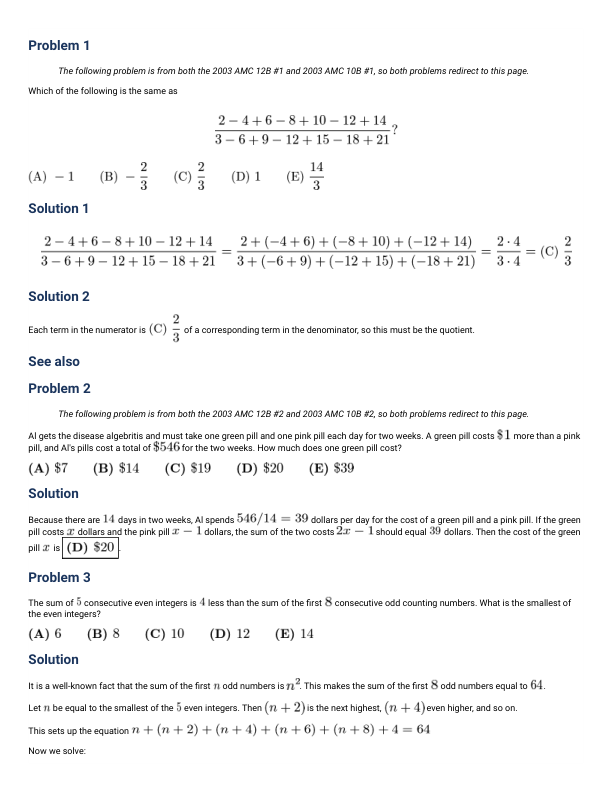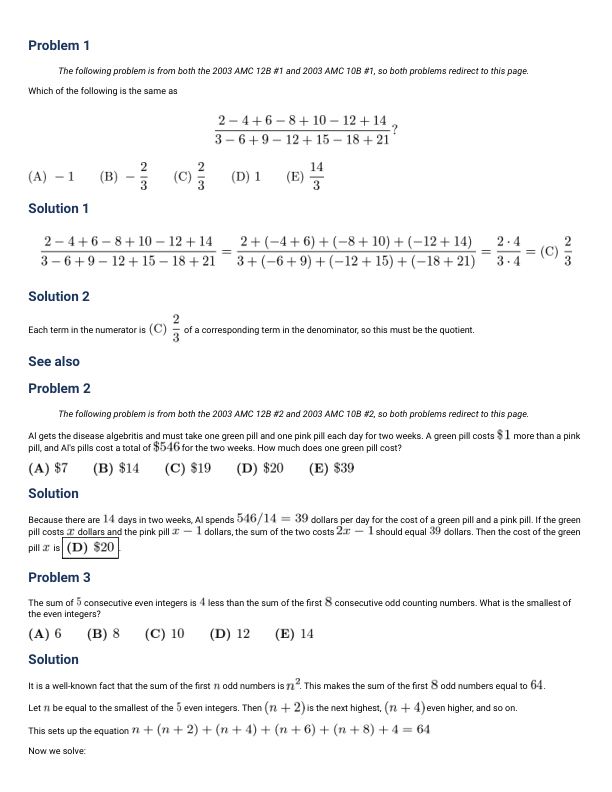2003 AMC amc10b 真题 答案 详解
| 序号 | 文件列表 | 说明 | ||
|---|---|---|---|---|
| 1 | 2003-amc10b-paper-eng.pdf | 4 页 | 198.70KB | 英文真题 |
| 2 | 2003-amc10b-key.pdf | 1 页 | 10.30KB | 真题答案 |
| 3 | 2003-amc10b-solution-eng.pdf | 20 页 | 979.69KB | 真题文字详解(英文) |
| 4 | 2003-amc10b-solution-eng-zh.pdf | 20 页 | 979.69KB | 真题文字详解(中英双语) |
英文真题
2003 AMC 10B Problems Problem 1 Which of the following is the same as $$\frac{2-4+6-8+10-12+14}{3-6+9-12+15-18+21}$$? (A) -1 (B) -\frac{2}{3} (C)\frac{2}{3} (D)1 (E)\frac{14}{3} Problem 2 Al gets the disease algebritis and must take one green pill and one pink pill each day for two weeks. A green pill costs $1 more than a pink pill, and Al's pills cost a total of $546 for the two weeks. How much does one green pill cost? (A) $7 (B) $14 (C) $19 (D) $20 (E) $39 Problem 3 The sum of 5 consecutive even integers is 4 less than the sum of the first 8 consecutive odd counting numbers. What is the smallest of the even integers? (A) 6 (B) 8 (C) 10 (D) 12 (E) 14 Problem 4 Rose fills each of the rectangular and square regions of her rectangular flower bed with a different type of flower. The lengths, in feet, of the rectangular regions in her flower bed are as shown in the figure. She plants one flower per square foot in each region. Asters cost $1 each, begonias $1.50 each, cannas $2 each, dahlias $2.50 each, and Easter lilies $3 each. What is the least possible cost, in dollars, for her garden? (A) 108 (B) 115 (C) 132 (D) 144 (E) 156 Problem 5 Moe uses a mower to cut his rectangular 90-foot by 150-foot lawn. The swath he cuts is 28 inches wide, but he overlaps each cut by 4 inches to make sure that no grass is missed. He walks at the rate of 5000 feet per hour while pushing the mower. Which of the following is closest to the number of hours it will take Moe to mow the lawn? (A) 0.75 (B) 0.8 (C) 1.35 (D) 1.5 (E) 3 Problem 6 Many television screens are rectangles that are measured by the length of their diagonals. The ratio of the horizontal length to the height in a standard television screen is 4:3. The horizontal length of a "27-inch" television screen is closest, in inches, to which of the following?

真题文字详解(英文)
Problem 1 The following problem is from both the 2003 AMC 12B #1 and 2003 AMC 10B #1, so both problems redirect to this page. Which of the following is the same as $$\frac{2-4+6-8+10-12+14}{3-6+9-12+15-18+21}$$? (A) -1 (B) -\frac{2}{3} (C) \frac{2}{3} (D) 1 (E) \frac{14}{3} Solution 1 $$\frac{2-4+6-8+10-12+14}{3-6+9-12+15-18+21}=\frac{2+(-4+6)+(-8+10)+(-12+14)}{3+(-6+9)+(-12+15)+(-18+21)}=\frac{2\cdot4}{3\cdot4}=(C)\frac{2}{3}$$ Solution 2 Each term in the numerator is (C) \frac{2}{3} of a corresponding term in the denominator, so this must be the quotient. See also Problem 2 The following problem is from both the 2003 AMC 12B #2 and 2003 AMC 10B #2, so both problems redirect to this page. Al gets the disease algebritis and must take one green pill and one pink pill each day for two weeks. A green pill costs $1 more than a pink pill, and Al's pills cost a total of $546 for the two weeks. How much does one green pill cost? (A) $7 (B) $14 (C) $19 (D) $20 (E) $39 Solution Because there are 14 days in two weeks, Al spends 546/14 = 39 dollars per day for the cost of a green pill and a pink pill. If the green pill costs x dollars and the pink pill x - 1 dollars, the sum of the two costs 2x - 1 should equal 39 dollars. Then the cost of the green pill x is (D) $20. Problem 3 The sum of 5 consecutive even integers is 4 less than the sum of the first 8 consecutive odd counting numbers. What is the smallest of the even integers? (A) 6 (B) 8 (C) 10 (D) 12 (E) 14 Solution It is a well-known fact that the sum of the first n odd numbers is n^2. This makes the sum of the first 8 odd numbers equal to 64. Let n be equal to the smallest of the 5 even integers. Then (n + 2) is the next highest, (n + 4) even higher, and so on. This sets up the equation n + (n + 2) + (n + 4) + (n + 6) + (n + 8) + 4 = 64 Now we solve:

真题文字详解(中英双语)
Problem 1 The following problem is from both the 2003 AMC 12B #1 and 2003 AMC 10B #1, so both problems redirect to this page. Which of the following is the same as $$\frac{2-4+6-8+10-12+14}{3-6+9-12+15-18+21}$$? (A) -1 (B) -\frac{2}{3} (C) \frac{2}{3} (D) 1 (E) \frac{14}{3} Solution 1 $$\frac{2-4+6-8+10-12+14}{3-6+9-12+15-18+21} = \frac{2 + (-4+6)+(-8+10)+(-12+14)}{3+(-6+9)+(-12+15)+(-18+21)} = \frac{2 \cdot 4}{3 \cdot 4} = (C)\frac{2}{3}$$ Solution 2 Each term in the numerator is (C) \frac{2}{3} of a corresponding term in the denominator, so this must be the quotient. See also Problem 2 The following problem is from both the 2003 AMC 12B #2 and 2003 AMC 10B #2, so both problems redirect to this page. Al gets the disease algebritis and must take one green pill and one pink pill each day for two weeks. A green pill costs $1 more than a pink pill, and Al's pills cost a total of $546 for the two weeks. How much does one green pill cost? (A) $7 (B) $14 (C) $19 (D) $20 (E) $39 Solution Because there are 14 days in two weeks, Al spends 546/14= 39 dollars per day for the cost of a green pill and a pink pill. If the green pill costs x dollars and the pink pill x - 1 dollars, the sum of the two costs 2x - 1 should equal 39 dollars. Then the cost of the green pill x is [D] $20. Problem 3 The sum of 5 consecutive even integers is 4 less than the sum of the first 8 consecutive odd counting numbers. What is the smallest of the even integers? (A) 6 (B) 8 (C) 10 (D) 12 (E) 14 Solution It is a well-known fact that the sum of the first n odd numbers is n^2. This makes the sum of the first 8 odd numbers equal to 64. Let n be equal to the smallest of the 5 even integers. Then (n + 2) is the next highest, (n + 4) even higher, and so on. This sets up the equation n + (n + 2) + (n + 4) + (n + 6) + (n + 8) + 4 = 64 Now we solve:

